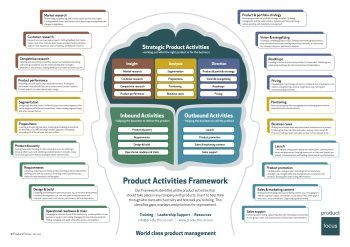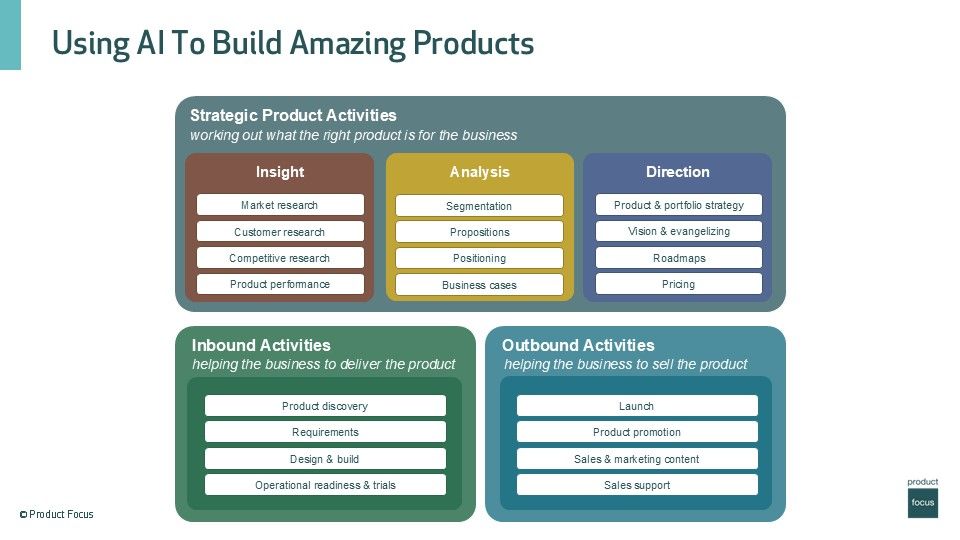
While AI has yet to master the art of reading our minds, it can help to increase your productivity as you manage products. What do we mean by this, and how can you use it?
AI as a tool for product managers
At Product Focus, we view AI as a companion – a tool to help product managers:
- AI is a tool to enhance productivity for product managers, not a replacement for them.
- Product managers need to develop skills in using AI tools effectively.
- A strong foundation in product management principles and practices remains essential.
Without product management skills and expertise, you will struggle to:
- Effectively guide and use AI tools.
- Critically evaluate AI outputs.
- Determine if AI-generated output is correct or appropriate for your specific product and context.
AI prompts for the product management lifecycle
Product management needs a vast array of skills and know-how, and the Product Activities Framework (PAF) is a great tool to demonstrate how AI can support various stages of the product lifecycle.
The PAF outlines the key activities involved in product management for any company.
- Strategic Product Activities (insight, analysis, direction) – to determine the right product for the business.
- Inbound Activities – to help the business deliver the product.
- Outbound Activities – to help the business sell the product.
In this blog, we share specific examples of AI-driven prompts—that you can use on tools like OpenAI’s ChatGPT, Google Gemini, or Microsoft CoPilot—to enhance each activity.
Watch and Listen: You can hear Cyril Le Roux talk through these examples in his webinar – you can also read more in our recent blog based on the webinar.
⚠️ When using AI, be mindful of customer confidentiality, data processing regulations, and AI legislation like the EU AI Act. Ensure that data is anonymized and adheres to your company’s policy regarding the use of AI in general and for data processing. You should consult your manager and legal team as necessary.

Figure 1: Product Activities Framework
Prompts for Insight Activities
Market research
- Find the latest market trends and forecasts for the [industry] industry.
- What are the top companies in the [industry] market and their market shares?
- Identify emerging technologies and innovations in the [industry] sector.
- Provide a SWOT analysis (Strengths, Weaknesses, Opportunities, Threats) for the [industry] market.
Customer research
- What are the current consumer preferences and behaviors in the [industry] market?
- Find recent customer reviews and feedback on the [name of product/service].
- What are the key demographics of the target audience for [name of product/service]?
- Identify popular forums and social media platforms where [industry] customers discuss products and services.
- What are the main pain points and needs of customers in the [industry] sector?
- Analyze the sentiment of the customer comments in this multilingual NPS/CSat* survey and provide an overall summary.
- Translate the comments in this NPS/CSat survey into English and categorize them into positive, neutral, and negative sentiments.
- Translate and analyze comments from this NPS/CSat survey to identify actionable insights for improving customer satisfaction.
*NPS (Net Promoter Score) and CSAT (Customer Satisfaction Score)
Competitive research
- List the top competitors of [company] in the [industry] market and their key strategies.
- Analyze recent news and developments about [competitor company].
- What are the strengths and weaknesses of [competitor company] in the [industry] market?
- Compare the product offerings and pricing strategies of [company] and its competitors.
- Find case studies of successful strategies used by companies in the [industry] sector.
Product performance
- What are the sales trends and performance metrics for [name of product/service]?
- Identify key performance indicators (KPIs) for evaluating the success of [name of product/service] in the market.
- Find reviews and ratings for [name of product/service] on popular e-commerce and review platforms.
- What are the user adoption rates and customer satisfaction levels for [name of product/service]?
- Analyze market penetration and growth potential for [name of product/service] in different regions.
Prompts for Strategic Product Analysis
Segmentation
- What are the key market segments for [industry] products/services?
- Identify niche markets and underserved segments in the [industry] sector.
- Find examples of successful segmentation strategies in the [industry] market.
Propositions
- Help me craft an elevator pitch, ask all the relevant questions and make three proposals.
- What are the unique selling propositions (USPs) of leading brands in the [industry] market?
Positioning
- Analyze the current market positioning of [name of product/service] and identify gaps or opportunities for differentiation.
- Develop three different positioning strategies for [name of product/service] and evaluate the potential impact of each on market perception.
- Suggest effective messaging and communication tactics to reinforce the positioning of [name of product/service] in the market.
Business cases
- Provide a revenue forecast for the next five years for [name of product/service], considering different market scenarios.
- Estimate the potential market share for [name of product/service] based on current market data and trends.
Prompts for Analyzing Product Direction
Product and portfolio strategy
- Perform a SWOT analysis on [company’s] existing product portfolio.
- Analyze the lifecycle stages of [company’s] products and recommend strategies for managing products at different stages (introduction, growth, maturity, decline).
- Analyze technological advancements in the [industry] and suggest how they can be leveraged to innovate [company’s] product offerings.
Vision and evangelizing
- Explain how the company’s vision statement can inform and shape the product vision for [name of product/service].
- Create 5 ambitious product vision variants for a product that addresses the main pain points and needs described below, while aligning with the company’s vision [describe pain points, needs and company vision].
Roadmaps
- Develop a list of prioritized features and initiatives for the product roadmap based on customer feedback, market trends, and business goals.
- Identify potential risks associated with the roadmap and develop mitigation strategies for each.
- Describe the long-term vision for the product and how the roadmap supports achieving it.
Pricing
- Analyze the current pricing trends in the [industry] market. How are competitors pricing similar products?
- Identify the different pricing models used in the [industry] sector and evaluate their effectiveness.
- Develop pricing strategies for different lifecycle stages to maximize revenue and market penetration.
Prompts for Inbound Activities
Product discovery
- Prepare a script for customer interviews based on the Mom Test principles, focusing on past behaviors and actions rather than opinions or hypotheticals. Apply it to the domain of [domain].
- Create a list of ODI* style outcomes in connection with the use of [name of product].
- Using the list of features described in the attached document, create a survey following the Kano methodology.
*ODI (Outcome-Driven Innovation)
Requirements
- Identify the major themes or epics for [name of product/service] based on the high-level functionalities and user needs.
- Break down each epic into smaller, manageable user stories that detail specific functionalities or features and include acceptance criteria.
- Define acceptance criteria for each user story to ensure clear and testable requirements. Use the format: ‘Given [context], when [action], then [outcome].’
Design and build
- Create wireframes for the main screens of [name of product/service], focusing on user flow and key interactions. (Requires a specialist UI/UX design tool).
- Design high-fidelity mock-ups for [name of product/service] that incorporate the brand’s visual identity and UI guidelines. (Requires a specialist UI/UX design tool).
- Estimate the tickets of the next sprint based on the previous sprints (refer to the article by Jeff Sutherland, co- creator of Scrum).
Operational readiness and trials
- Create training materials and guides that cover the key operational processes and procedures for [name of product/service] based on [document uploaded].
- Prepare a status update for key stakeholders on the progress of operational readiness activities for [name of product/service], based on [transcript of a call].
Prompts for Outbound Activities
Launch
- Develop a detailed launch plan for [name of product/service], including key milestones, timelines, and responsibilities.
- Create a checklist of tasks to be completed before, during, and after the launch of [name of product/service].
- Identify potential risks and challenges associated with the product launch and propose mitigation strategies.
Product promotion
- Design a multi-channel marketing campaign to promote [name of product/service], including social media, email, and paid advertising.
- Identify key influencers and partners who can help amplify the reach of the product promotion.
- Create a social media engagement plan to interact with customers and gather feedback during the promotion period.
Sales and marketing content
- Create a series of email templates for different stages of the sales funnel, from awareness to conversion.
- Create competitive battle cards that provide key information about competitors, their strengths and weaknesses, and strategies for differentiation.
Sales support
- Develop a comprehensive sales playbook for [name of product/service], including key selling points, objection handling, and competitive positioning using [PRD* or another similar document uploaded].
- Design interactive training sessions or workshops to help sales reps practice and improve their selling skills for [name of product/service].
*PRD (Product Requirements Document)
Tips on creating Your Own Prompts
- Provide context on the request, including the role that the AI is to play.
- State the goal.
- Be as clear, specific and unambiguous as possible.
- Break down the task into steps.
- Provide examples of outputs.
- Specify a format and a tone of voice.
- Allow the AI to ask questions.
- For the more complex cases, ask the AI to help craft the prompt.
How are you using AI as a product manager?
We’d really like to hear from you! Is AI helping you? How? Where are you having success and improving your productivity? What’s still challenging?
Don’t forget that you still need to learn product management skills and best practices – how else will you know if AI is giving you correct output?


Leave a comment